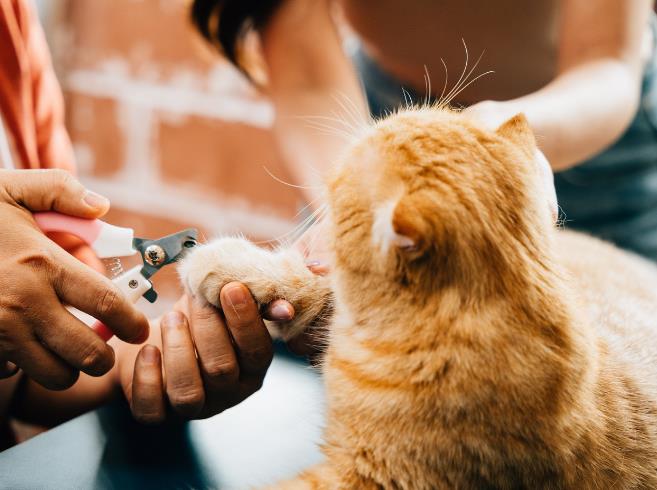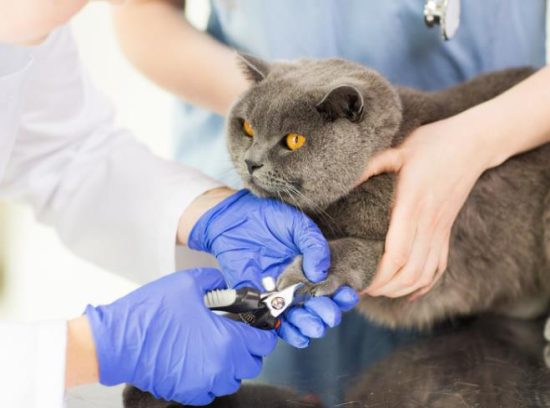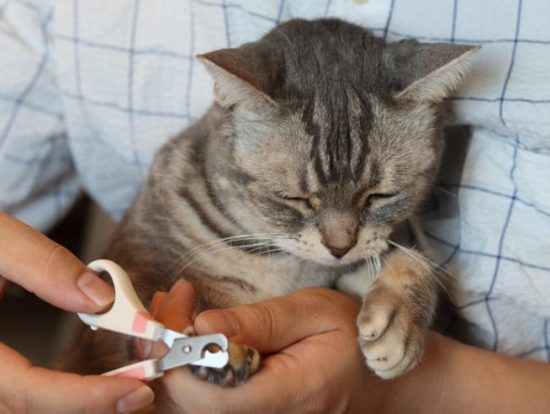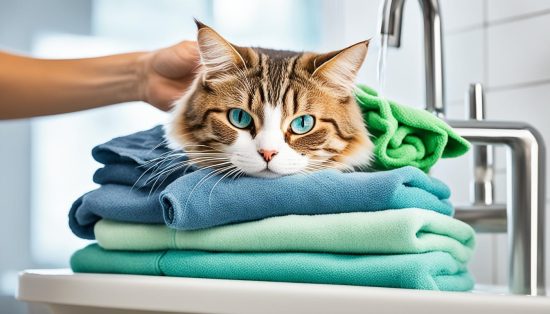How to Trim Cat Nails: A Step-by-Step Guide
Trim your cat’s nails safely and easily with our step-by-step guide, which covers how to trim cat nails, the tools needed, and tips for a stress-free experience.

Did you know that the average cat has 18 claws? With such a substantial number of nails, regular trimming is essential for your feline friend’s health and your home’s protection. As a professional groomer with 12 years of experience, I’m here to provide a comprehensive guide on how to trim cat nails safely and effectively.
Why Trimming Your Cat’s Nails is Important?
Regularly trimming your cat’s nails is essential for several reasons. First, overgrown nails can cause injury to your cat, such as pain and discomfort when walking, and can even lead to changes in gait that result in long-term joint issues. Additionally, sharp, untrimmed nails pose a risk to you and your family, as they can easily scratch and cause injury.
Secondly, allowing your cat’s nails to grow too long can lead to damage to your furniture, carpets, and other belongings as they scratch. Trimming their nails is a simple and effective way to protect your home. Finally, nail trimming is a humane alternative to declawing, which is a controversial and often painful procedure that can have long-lasting negative effects on your cat’s well-being.
Prevents Injury to Your Cat and Family

Trimming your cat’s nails is crucial for preventing injuries to both your cat and your family. Overgrown nails can easily become snagged on fabrics, carpets, or other objects, leading to painful breaks or tears in the nail. Additionally, sharp nails can accidentally scratch family members during play or when your cat is being handled. Regular nail trims reduce the risk of such injuries, ensuring a safer and more comfortable environment for everyone.
Protects Your Furniture and Belongings
Regularly trimming your cat’s nails helps protect your furniture and belongings from damage. Cats instinctively scratch to mark their territory and to maintain their claw health, but overgrown nails can cause significant damage to upholstery, carpets, and wooden surfaces. By trimming your cat’s nails, you can minimize the extent of scratching damage, preserving the integrity and appearance of your household items.
Alternative to Declawing
Supplies Needed for Trimming Cat Nails
Before you begin trimming your cat’s nails, it’s important to have the right supplies on hand. The most essential tool is a pair of cat-specific nail clippers or scissors. These are designed with the unique shape and thickness of a cat’s nails in mind, unlike human nail clippers which can cause the nail to split or break. You’ll also want to have styptic powder or cornstarch available in case you accidentally cut the quick and cause bleeding. Finally, having some tasty cat treats on hand can help make the experience positive and rewarding for your feline friend.
Cat Nail Clippers or Scissors

Investing in quality cat nail clippers or scissors is crucial for a safe and effective nail trimming session. These tools are specifically designed to accommodate the shape and size of a cat’s nails, providing a clean, precise cut without the risk of splitting or breaking the nail. Unlike human nail clippers, cat-specific tools are essential for ensuring your pet’s comfort and well-being during the process.
Styptic Powder or Cornstarch
Despite your best efforts, it’s possible that you may accidentally cut into the quick, causing your cat’s nail to bleed. Having styptic powder or cornstarch on hand can help stop the bleeding and prevent further irritation. These simple remedies can quickly and effectively halt any unwanted bleeding, allowing you to continue the nail trimming session without undue stress for your cat.
Cat Treats
Rewarding your cat with their favorite treats during and after the nail trimming process can make a significant difference in their overall experience. Offering these tasty morsels helps associate the activity with something positive, reinforcing the behavior and making future nail trims more cooperative and enjoyable for both you and your feline friend. Keeping a supply of cat treats nearby ensures you can provide immediate positive reinforcement throughout the session.
Choosing the Right Time and Place

When it comes to trimming your cat’s nails, timing and location are crucial. Is nail trimming painful for cats? The answer lies in creating a comfortable and stress-free environment for the process. Choose a quiet, distraction-free area of your home, away from noisy appliances, other pets, or children. This will help keep your cat calm and relaxed during the nail trimming session.
Selecting the right spot is key to ensuring a positive experience for your feline friend. Look for a cozy, low-traffic area of your home that is free from loud noises or sudden movements. This will help your cat feel secure and at ease, making the nail trimming process much smoother.
Before attempting to trim your cat’s nails, take a moment to observe their behavior and body language. Look for signs of calmness, such as slow, relaxed movements, a quiet demeanor, and a lack of agitation or stress. If your cat seems anxious or overly energetic, it’s best to wait for a more suitable moment to ensure a positive experience for both you and your feline friend.
Preparing Your Cat for Nail Trimming
To make the nail-trimming process as stress-free as possible, it’s important to gradually acclimate your cat to having their paws handled. do scratching posts trim cats’ nails? This gradual approach will help your feline friend feel more comfortable and cooperative during the actual trimming session.
Acclimate Your Cat to Having Paws Handled
Start by gently touching and massaging your cat’s paws, offering treats and praise to associate the experience with positive reinforcement. This will help your cat become more comfortable with having their paws manipulated, making the nail-trimming process much easier in the long run.
Practice Extending the Nails
Once your cat is comfortable with having their paws handled, you can practice extending their nails one at a time. This will get your cat used to the sensation of their nails being exposed, preparing them for the actual trimming. do scratching posts trim cats’ nails? Remember to keep the sessions short and rewarding, ensuring your cat remains calm and relaxed throughout the process.
How to Trim Cat Nails?
Trimming a cat’s nails can be a delicate process, but with patience and the right approach, it can be done safely.
Here’s a step-by-step guide:
- Prepare the Supplies: Gather a pair of cat nail clippers, styptic powder (to stop bleeding if you accidentally cut too short), and treats for afterward.
- Get Your Cat Comfortable: Sit in a quiet, well-lit room with your cat on a stable surface like a table or your lap. Speak to your cat soothingly and offer treats to create a positive association.
- Hold Your Cat’s Paw: Gently take one of your cat’s paws in your hand. Press lightly on the paw pads to extend the claws.
- Identify the Quick: Look for the pink area inside the nail – this is the quick, which contains blood vessels and nerves. Avoid cutting into the quick, as it can be painful and cause bleeding.
- Trim the Nail: Carefully trim the tip of the nail, taking off only the sharp, translucent tip. Be cautious and go slowly to avoid cutting the quick.
- Repeat for Each Nail: Trim the rest of the nails, working on one paw at a time. Remember to give treats and praise between each paw to keep your cat calm and cooperative.
- Apply Styptic Powder (if needed): If you accidentally cut the quick and there is bleeding, apply a small amount of styptic powder to the nail tip to stop the bleeding.
- Reward Your Cat: Once you’re finished, reward your cat with treats and praise. This will help them associate nail trimming with positive experiences.
- Repeat Regularly: Trim your cat’s nails every 2-4 weeks to keep them short and blunt. Over time, your cat may become more comfortable with the process.
Always monitor your cat’s behavior during and after trimming. If they become too stressed or if you’re unsure about trimming their nails, consult a veterinarian or professional groomer for assistance.
Trim a Small Amount, Avoiding the Quick
Rather than attempting to cut the entire nail in one pass, it’s best to take off a small amount at a time. This gradual approach helps you avoid accidentally cutting into the quick, which can cause bleeding and distress for your cat. By trimming just the tip of the nail, you can keep your cat’s claws healthy and well-maintained without risking injury.
Dealing with Accidental Quicking
Despite your best efforts, it’s possible that you may accidentally cut into the quick, causing your cat’s nail to bleed. If this happens, remain calm and apply a small amount of styptic powder or cornstarch to the affected nail to stop the bleeding. The quick is the sensitive, blood-rich part of the nail, and cutting into it can be painful for your cat. By staying composed, you can help prevent further distress and ensure a positive experience for your feline friend.
Remain Calm and Apply Styptic Powder
If you do accidentally cut the quick and your cat’s nail starts to bleed, the most important thing is to remain calm. Cats can sense when their owners are anxious or upset, which can exacerbate the situation. Gently apply a small amount of styptic powder or cornstarch to the affected nail to help stop the bleeding. This will not only provide relief for your cat, but it will also prevent the risk of infection. Reassure your cat with soothing words and offer their favorite treats to end the session on a positive note.
When to Seek Veterinary Assistance?
In most cases, applying styptic powder or cornstarch will be enough to stop the bleeding and prevent any further issues. However, if the bleeding persists or your cat seems to be in significant distress, it’s best to seek veterinary assistance. Your vet can properly assess the injury, provide any necessary treatment, and ensure that your cat’s nail is healing properly. This is especially important if the bleeding is excessive or if you notice signs of infection, such as redness, swelling, or a foul odor. By acting quickly and consulting a professional, you can help ensure your cat’s [will cat nails grow back?] safety and well-being.
Rewarding and Positive Reinforcement

Throughout the nail-trimming process, it’s important to use positive reinforcement to help your cat associate the experience with something enjoyable. By offering your cat’s favorite treats after each nail is trimmed, and providing plenty of praise and affection, you can create a positive association that will make future nail trims much easier and less stressful for your feline friend.
As you carefully trim each of your cat’s nails, be sure to offer a tasty treat immediately afterward. This not only rewards your cat for cooperating, but it also helps them understand that the nail trims are not a negative experience. Pair the treats with plenty of affectionate petting and soothing words to reinforce the positive association.
Tips and Tricks for Successful Nail Trims
Trimming your cat’s nails can be a challenging task, but with patience and the right techniques, you can make it a much more positive experience. Remain relaxed and calm throughout the process, as your cat will pick up on your energy. If your cat becomes too agitated, don’t hesitate to stop and try again another day – it’s better to take it slow and build up your cat’s trust than to force the issue.
Practice Patience and Remain Relaxed
Cats can sense when their owners are feeling anxious or stressed, and this can make them more likely to resist the nail trimming process. By remaining calm and patient, you’ll set the tone for a more positive experience for both you and your feline friend. Take your time, and remember that it may take several sessions before your cat becomes comfortable with the procedure.
Use Calming Techniques Like Music or Pheromones
In addition to maintaining a relaxed demeanor, you can try calming techniques to help soothe your cat during the nail trimming process. Playing soft, soothing music in the background can help create a more tranquil atmosphere, while using pheromone diffusers or sprays can help reduce stress and anxiety in your cat. These techniques can make the experience more pleasant for both you and your cat.
End Note
Regularly trimming your cat’s nails is essential to their grooming and overall health. Is it necessary to trim a cat’s claws? Absolutely. By following the step-by-step guide and tips provided in this article, you can learn how to trim your cat’s nails safely and effectively, while also creating a positive experience for both you and your feline friend. Remember to be patient, use positive reinforcement, and seek veterinary assistance if you encounter any issues. You can keep your cat’s nails in top condition with practice and persistence and protect your home and loved ones.
Trimming your cat’s nails is important for their comfort and well-being and helps prevent damage to your furniture and belongings. By taking the time to trim your cat’s claws regularly, you can ensure their overall health and maintain a harmonious living environment. Is it necessary to trim a cat’s claws? The answer is a resounding yes, and this comprehensive guide has given you the knowledge and tools to do so successfully.
FAQs on how to trim cat nails
Is it necessary to trim a cat’s claws?
Regularly trimming your cat’s nails is an essential part of grooming and maintaining your pet’s health. Overgrown nails can cause injury, pain, and discomfort for your cat, as well as damage to your furniture and belongings. Trimming their nails is a humane alternative to declawing, which can have long-lasting negative effects.
What to do if your cat won’t let you cut their nails?
It’s important to gradually acclimate your cat to having their paws handled and the nail trimming process. Start by gently touching and massaging their paws, offering treats and praise. Practice extending their nails one at a time to get them used to the sensation. This will make the actual trimming session much easier, as your cat will be more relaxed and cooperative.
Is nail trimming painful for cats?
Nail trimming should not be painful for cats if done properly. Be sure to cut at a 45-degree angle, trimming only the tip of the nail and avoiding the quick, which is the sensitive, blood-rich part of the nail. If you accidentally cut the quick, causing bleeding, remain calm, apply styptic powder or cornstarch, and seek veterinary assistance if the bleeding persists.
Do scratching posts trim cats’ nails?
Scratching posts can help wear down and dull your cat’s nails, but they do not replace the need for regular nail trimming. Scratching helps remove the outer layer of the nail, but it does not address the underlying growth or shape of the nail. Trimming remains an essential part of your cat’s grooming routine.
Can I use human nail clippers on my cat?
It’s best to use cat-specific nail clippers or scissors, as they are designed with the unique shape and thickness of a cat’s nails in mind. Human nail clippers can cause the nail to split or break, potentially leading to injury or discomfort for your cat.
How often should I cut my cat’s nails?
The frequency of nail trimming can vary depending on your cat’s individual needs, activity level, and nail growth rate. As a general guideline, most cats require nail trims every 4-6 weeks to maintain healthy, manageable nails.
Why do cats hate having their nails cut?
Cats can be wary of having their paws handled and nails trimmed due to their sensitivity and the potential for discomfort or pain if not done properly. Gradual desensitization, positive reinforcement, and creating a calm, stress-free environment can help make the nail trimming process more tolerable for your cat.
Will cat nails grow back?
Yes, cat nails will grow back after being trimmed. The nails are constantly growing, so regular trimming is necessary to maintain their health and prevent overgrowth.
How to keep cat claws dull?
While scratching posts can help wear down and dull your cat’s nails, regular nail trimming is still necessary to maintain their health and prevent damage to your furniture and belongings. Trimming their nails every 4-6 weeks is the most effective way to keep their claws dull and manageable.







